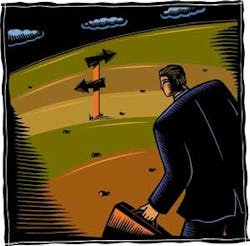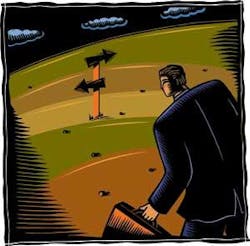Trade shows … A shifting paradigm
By Scott Mahnken, Edge Marketing, Dental Marketing Consultant
Dental manufacturers are witnessing a new dynamic taking place at national dental meetings. Decreasing attendance is causing manufacturers to reevaluate the return on investment of today’s meetings. Gone are the boom times of the ’80s and ’90s when the meeting aisles were bustling with doctors and their staff shopping as teams. Just a few years ago, it was not uncommon to see office teams participating in manufacturers’ reps’ presentations, sharing opinions and offering feedback. This created an ideal setting for salespeople as they had an audience of influencers along with the ultimate decision makers. Manufacturers and their reps appreciated the value of having such a captive audience.
Today, you’re more likely to see the aisles filled with staff members gathering promotional gifts and product literature for their offices. The number of dentists walking the aisles and shopping for equipment and instruments has declined noticeably.
“The number of quality presentations that we’re giving to dentists is down over 50% when compared with meetings in the past, and I hear the same from my colleagues in the industry,” said a fellow dental industry director of marketing. “It’s evident that the dynamic has changed; thus, we’ve repositioned our trade show plans for 2009.”
Certainly, dentists still find value in attending national dental meetings, but many have changed their purpose for attending. Fewer and fewer dentists approach the meeting as a day to close the office, bring the staff to the show, and have an upscale team luncheon. Higher expenses along with the increased ability to purchase products through alternate methods, such as online (and still get discounts once held sacred for meetings), have influenced dentists to rethink their meeting strategies. It’s less costly for dentists to just give their staffs the day off rather than pay them to attend the meeting. Dentists report that closing the office for the day is already a big enough investment; therefore, many seek to cut costs by leaving staff behind.
Some of the most respected key option leaders utilize meeting venues to get their messages across to larger groups of dentists. While attendance at continuing education lectures remains strong, many lecture halls are seeing slight declines in attendance attributed to the shifting paradigm and the increase of quality CE content now available on the Internet. Check out www.ineedce.com or www.perioeducation.com as examples.
Taking CE courses at national dental meetings can be very convenient for dentists, but many manufacturers feel that the courses distract from their chance to interact with the dentists. If dentists spend their entire morning participating in CE lectures, they often just breeze through a few trade show aisles before heading home or back to the office. Manufacturers are feeling short–changed as they perceive the CE lectures are taking away their opportunity to present their products to dentists attending the meeting.
Travel costs and inconveniences are other factors negatively impacting national meetings. Everyone has been affected by the recent spike in oil and the result is fewer flights, higher ticket fees, and planes that are filled to capacity. Attending meetings is simply a bit more draining than it was in the past. It’s not unusual to experience lengthy delays at the airport, whereas delays used to be a rare occurrence.
What does the future hold for national dental meetings?
Virtual meetings – Virtual online dental meetings offer some very attractive upsides. No delays at the airport, no travel expenses, and you don’t have to wear a suit. Virtual meetings offer CE, product information, and interactive forums all delivered conveniently to your laptop or PC. PennWell, parent company of Proofs, has already launched virtual trade shows for both the dentist and the hygienist.
Manufacturer cutbacks – Manufacturers are already streamlining staff, requesting smaller booth space, and spending less on promotions. Many have lowered their meeting sales forecasts substantially based upon past years’ results.
Fewer days, fewer hours – A few meetings have already trimmed the number of days the meeting is held, along with the number of hours the show floor is open.
Creative promotions – Look for manufacturers to identify the “hot promotion” for the meeting. Squeeze balls, pens with company logos, and little stuffed animals are things of the past and simply don’t generate booth traffic or sales. One example of a 21st century promotion was Heraeus Kulzer’s offer of an iPod, which came with CE courses already downloaded.
Fewer meetings – Manufacturers that would once attend all of the national meetings are considering attending fewer meetings as the ROI continues to shrink. Specialty meetings will most likely continue in a traditional manner, yet one recent meeting saw a significant drop in attendance. It seems that everyone will be required to make some adjustments as the meeting paradigm continues to shift.
If the hosts of the national dental meetings want to continue to survive these changing times, it will require a corroborative effort on the part of the meeting hosts, manufacturers, and lecturers. If the groups work together, it will be very easy to identify each group’s objectives and concerns in order to formulate a new approach to meetings.
The current problem is that no group is taking a leadership role to identify and implement better solutions. It’s in everyone’s best interest to find new solutions that address each party need to succeed. Should things continue as they are trending, we will eventually witness a downturn, which might have an everlasting impact on meetings.
Who needs to take the “bull by the horns”? The meeting hosts are aware of the declines and understand that many manufacturers are getting genuinely concerned. Yet the meeting hosts focus on one meeting – theirs; therefore, they only see a snapshot of the shifting paradigm.
Thought leaders and lecturers work independently or are representing a manufacturer; thus, they have minimal opportunity to institute change.
The responsibility to lead the industry to the next level should fall upon the manufacturers and distributors – all of whom have the most to lose or gain.
The top executives with leading dental manufacturers need to combine their strengths and devise a plan to implement change – and fast – because the clock is ticking. Manufacturers and dental product distributors invest thousands and thousands of dollars attending, staffing, and promoting each meeting. The hundreds of manufacturers need to “think as one” because, in essence, they all have the same objectives, and certainly, they are all suffering in the current environment.
Imagine if the show hosts – lecturers and manufacturers – could all work together. Is it impossible to develop a plan that suits everyone’s needs? Certainly not! But we need someone to take that leadership role because things won’t get better until a few substantial changes are put into place.
A few suggestions…
- Eliminate/minimize the conflict of conducting CE courses during prime exhibit hours. Start CE at 7a.m. and end the first session at 10 a.m. Offer late afternoon CE courses from 4 p.m. to 6 p.m. or later.
- Show hosts should offer creative incentives with the objective of generating more dentists at the show.
- Research – The answer is out there somewhere. Each meeting host should be required to conduct substantial research with their target audience, learning about their preferences and concerns.
When we look around us at all the changes that have taken place in our personal and professional lives, it shouldn’t surprise us that change is essential for the national meetings to thrive once again.
Scott Mahnken is the president of Edge Marketing – www.go–to–guru.com – and his background includes experience with a leading dental advertising agency, product and marketing manager for two dental manufacturers, and developer of the Arc Mesa National Dental Continuing Education Network. Mahnken has more than 16 years of dental sales, marketing and meeting experience, and is on the editorial board of The Dental Entrepreneur, a publication distributed through the dental schools to junior and senior dental students. Mahnken resides in New Jersey with his wife, Dr. Joy Mahnken, and their two children, Courtney and Lindsey.

